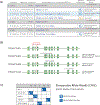PharmVar GeneFocus: CYP3A5
- PMID: 35202484
- PMCID: PMC9399309
- DOI: 10.1002/cpt.2563
PharmVar GeneFocus: CYP3A5
Abstract
The Pharmacogene Variation Consortium (PharmVar) catalogs star (*) allele nomenclature for the polymorphic human CYP3A5 gene. Genetic variation within the CYP3A5 gene locus impacts the metabolism of several clinically important drugs, including the immunosuppressants tacrolimus, sirolimus, cyclosporine, and the benzodiazepine midazolam. Variable CYP3A5 activity is of clinical importance regarding tacrolimus metabolism. This GeneFocus provides a CYP3A5 gene summary with a focus on aspects regarding standardized nomenclature. In addition, this review also summarizes recent changes and updates, including the retirement of several allelic variants and provides an overview of how PharmVar CYP3A5 star allele nomenclature is utilized by the Pharmacogenomics Knowledgebase (PharmGKB) and the Clinical Pharmacogenetics Implementation Consortium (CPIC).
© 2022 The Authors. Clinical Pharmacology & Therapeutics © 2022 American Society for Clinical Pharmacology and Therapeutics.
Conflict of interest statement
Conflicts of Interest:
Indiana University School of Medicine Pharmacogenomics Laboratory is a fee-for-service clinical laboratory that offers clinical pharmacogenetic testing. V.M.L. is co-founder and shareholder of PersoMedix AB, CEO and shareholder of HepaPredict AB and discloses consultancy work for Enginzyme AB. Sema4 is a fee-for-service clinical laboratory that offers clinical pharmacogenetic testing. B.E.R. is a paid employee of Sema4 and the founder and C.E.O. of Phoenix Laboratory Consulting, LLC.
All other authors declared no competing interests for this work.
Figures



References
-
- Aoyama T et al. Cytochrome P-450 hPCN3, a novel cytochrome P-450 IIIA gene product that is differentially expressed in adult human liver. cDNA and deduced amino acid sequence and distinct specificities of cDNA-expressed hPCN1 and hPCN3 for the metabolism of steroid hormones and cyclosporine. J Biol Chem 264, 10388–95 (1989). - PubMed
-
- Schuetz JD, Molowa DT & Guzelian PS Characterization of a cDNA encoding a new member of the glucocorticoid-responsive cytochromes P450 in human liver. Arch Biochem Biophys 274, 355–65 (1989). - PubMed
-
- Jounaidi Y, Hyrailles V, Gervot L & Maurel P Detection of CYP3A5 allelic variant: a candidate for the polymorphic expression of the protein? Biochem Biophys Res Commun 221, 466–70 (1996). - PubMed
-
- Hustert E et al. The genetic determinants of the CYP3A5 polymorphism. Pharmacogenetics 11, 773–9 (2001). - PubMed
-
- Kuehl P et al. Sequence diversity in CYP3A promoters and characterization of the genetic basis of polymorphic CYP3A5 expression. Nat Genet 27, 383–91 (2001). - PubMed
Publication types
MeSH terms
Substances
Grants and funding
LinkOut - more resources
Full Text Sources

